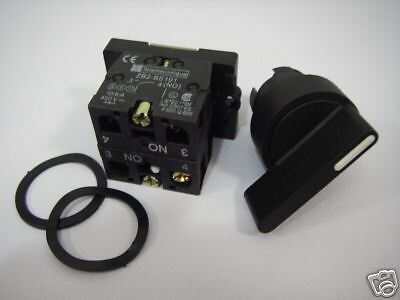kal
Well-Known Member
Hey guys!
I'm trying to buy a bunch of good industrial water/oil resistant buttons off of Ebay to use in my brewing control panel. Names like Allen-Bradley, Cutler Hammer, ABB, etc. Stuff that can live up to abuse. Stuff I'm used to seeing on plant floors.
Problem is the terminology. Some of it doesn't make sense to me and I'm familiar with terms like DPST (double pole/double throw), NO (normally open), NC (normally closed). Some of this stuff baffles me as they never seem to tell you how many poles or throws any of these switches have.
Example 1: NEW 22MM Selector Switch 3 Position Maintained 1NO/1NC
Ebay Link

It says it's a "SELECTOR SWITCH, 3 POSITION * MAINTAINED, 1 NO/1NC". Ok, it's switch with 3 positions but what's open/closed in each of the 3 positions? How can it have 1 NO contact and 1 NC contact? Under which circumstances? How many poles? Since it's 3 position is that 3-throw?
Example 2: PUSHBUTTON SELECTOR SWITCH AB ALLEN BRADLEY 800T-H2 XA
Ebay Link

Seems simple. It says it's a "2 P0SITION SELECTOR SWITCH. 1 NORMALLY OPEN AND 1 NORMALLY CLOSED CONTACT BLOCK". Ok, that makes sense, but why the word PUSHBUTTON in the title? How's that possible? It's a 2-position rotating switch. Or is it?
Example 3: Telemecanique Latching Select ON-OFF-ON Switch,EJ33
Ebay Link

It says it's a "Selector Switch. ON(left)-OFF(middle)-ON(right) LATCHING TYPE.". So it's 3 throw right? Or is it? But exactly how are the contacts wired? How am I supposed to know that? What's "Latching" mean? Does that mean "maintained"? (Ie: not momentary contact?)
Simple SPST switches (like example 2) are easy. Problem is that I'm looking for a DP3T (double pole, 3 throw) switch because I want to be able to be able to do the following in one switch so that only either my BK or HLT element is on at once in my 30A setup:
(1) Have BK PID send a control signal to BK SSR while HLT PID is cut off from HLT SSR.
(2) Both PIDs cut off from sending a signal to the PIDs (Switch center/off position).
(3) Have HLT PID send a control signal to HLT SSR while BK PID is cut off from BK SSR.
Forgetting Ebay for a moment, can anyone recommend any online stores that sell NEMA 4/12 style switches/buttons/pilot lights?
Kal
I'm trying to buy a bunch of good industrial water/oil resistant buttons off of Ebay to use in my brewing control panel. Names like Allen-Bradley, Cutler Hammer, ABB, etc. Stuff that can live up to abuse. Stuff I'm used to seeing on plant floors.
Problem is the terminology. Some of it doesn't make sense to me and I'm familiar with terms like DPST (double pole/double throw), NO (normally open), NC (normally closed). Some of this stuff baffles me as they never seem to tell you how many poles or throws any of these switches have.
Example 1: NEW 22MM Selector Switch 3 Position Maintained 1NO/1NC
Ebay Link

It says it's a "SELECTOR SWITCH, 3 POSITION * MAINTAINED, 1 NO/1NC". Ok, it's switch with 3 positions but what's open/closed in each of the 3 positions? How can it have 1 NO contact and 1 NC contact? Under which circumstances? How many poles? Since it's 3 position is that 3-throw?
Example 2: PUSHBUTTON SELECTOR SWITCH AB ALLEN BRADLEY 800T-H2 XA
Ebay Link

Seems simple. It says it's a "2 P0SITION SELECTOR SWITCH. 1 NORMALLY OPEN AND 1 NORMALLY CLOSED CONTACT BLOCK". Ok, that makes sense, but why the word PUSHBUTTON in the title? How's that possible? It's a 2-position rotating switch. Or is it?
Example 3: Telemecanique Latching Select ON-OFF-ON Switch,EJ33
Ebay Link

It says it's a "Selector Switch. ON(left)-OFF(middle)-ON(right) LATCHING TYPE.". So it's 3 throw right? Or is it? But exactly how are the contacts wired? How am I supposed to know that? What's "Latching" mean? Does that mean "maintained"? (Ie: not momentary contact?)
Simple SPST switches (like example 2) are easy. Problem is that I'm looking for a DP3T (double pole, 3 throw) switch because I want to be able to be able to do the following in one switch so that only either my BK or HLT element is on at once in my 30A setup:
(1) Have BK PID send a control signal to BK SSR while HLT PID is cut off from HLT SSR.
(2) Both PIDs cut off from sending a signal to the PIDs (Switch center/off position).
(3) Have HLT PID send a control signal to HLT SSR while BK PID is cut off from BK SSR.
Forgetting Ebay for a moment, can anyone recommend any online stores that sell NEMA 4/12 style switches/buttons/pilot lights?
Kal









